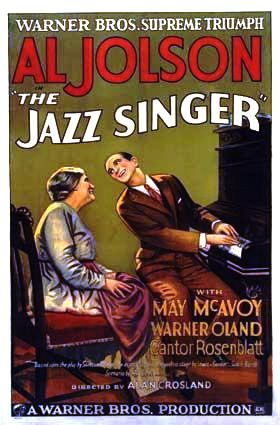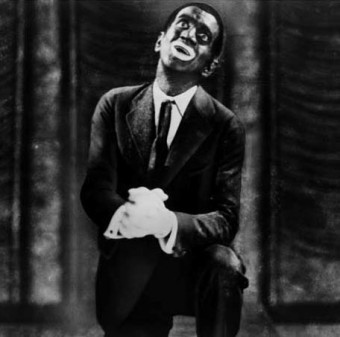This Day in History: October 6th- The Jazz Singer
This Day In History: October 6, 1927
 “Wait a minute, wait a minute, you ain’t heard nothin’ yet!” – Al Jolson in “The Jazz Singer”
“Wait a minute, wait a minute, you ain’t heard nothin’ yet!” – Al Jolson in “The Jazz Singer”
When the film “The Jazz Singer” was released on October 6, 1927, it was the end of one era and the dawn of another. While not a “talkie” in the true sense, it sounded the death knell for the silent picture. You see, despite being known as the first talking picture, “The Jazz Singer” is really nothing more than a silent movie interspersed with a few musical numbers, some improvised lines from the film’s oft’ misinterpreted star Al Jolson (see: Al Jolson: Hero or Villain?), and a bit of scripted dialogue.
Although Thomas Edison originally intended moving pictures to incorporate sound, the silent movie era was in full swing before sound technology could catch up with the images on the screen. In any case, studio heads like Jack Warner remained unconvinced of talking pictures’ commercial viability: “They fail to take into account the international language of the silent pictures, and the unconscious share of each onlooker in creating the play, the action, the plot and the imagined dialogue for himself.”
But Warner Brothers Studio went ahead with “The Jazz Singer,” the story of a rebellious young man from a strict Jewish family who leaves the fold to make his name as a – you guessed it – jazz singer. At the film’s climax, our hero must choose between starring on Broadway or singing at the synagogue for his dying father.
 Despite being one of the most important films in Hollywood history, the movie has not aged well. Al Jolson was a megastar in his day – by that point, he had already conquered the stage, radio and recordings. Although his music was considered hip at the time, jams like “Toot Toot Tootsie” sound totally corny to modern ears, and Jolson’s over-the-top acting style is only suitable for parody. More than any of that, the black-face rendition of “Mammy” is amazingly cringe-worthy today, though Jolson’s intentions were (seemingly) good, as you’ll soon see.
Despite being one of the most important films in Hollywood history, the movie has not aged well. Al Jolson was a megastar in his day – by that point, he had already conquered the stage, radio and recordings. Although his music was considered hip at the time, jams like “Toot Toot Tootsie” sound totally corny to modern ears, and Jolson’s over-the-top acting style is only suitable for parody. More than any of that, the black-face rendition of “Mammy” is amazingly cringe-worthy today, though Jolson’s intentions were (seemingly) good, as you’ll soon see.
“Blackface,” which is captured for posterity in many films of the first half of the twentieth century, is a sad reminder to most people of the ridicule and mistreatment of African-Americans. As for Jolson, he didn’t always use “blackface” in his act, but because most people today know him only by “The Jazz Singer,” his reputation is often as a symbol of a very backward time. However, Jolson was, ironically given the perception today, an early crusader for the rights of African-Americans.
Jolson also insisted on the hiring and fair treatment of black people at a time when this was an outlandish concept to many in America. (For example, at the time members of the KKK are estimated to have accounted for about 15% of the U.S.’s voting-age population.) He also crusaded for equal rights for African-American as early as 1911, when he was 25. Through his very controversial portrayals, and advocating for black performers, Jolson helped pave the way for the success of such legends as Louis Armstrong, Ethyl Waters, Duke Ellington and Cab Calloway. As the St. James Encyclopedia of Popular Culture stated, “Almost single-handedly, Jolson helped to introduce African-American musical innovations like jazz, ragtime, and the blues to white audiences.”
As for his “blackface” persona which seems to (almost literally) fly in the face of his apparent true feelings on race, this persona was often used by Jolson as a means to introduce white audiences to black culture, and also to make fun of the general idea of “white supremacy.” As such, when black audiences saw “The Jazz Singer,” rather than boycott it, a Harlem newspaper, Amsterdam News (today “the oldest Black newspaper in the country,” according to their website), stated that The Jazz Singer was “one of the greatest pictures ever produced,” and that, “Every colored performer is proud of him (Jolson).” (For much more on this, see: Al Jolson- Misunderstood Hero or Villain?)
Beyond the controversy, “The Jazz Singer” received one of the first ever Academy Awards in 1927 for being a “pioneering talking picture.” And even though contemporary audiences loved the new technology that allowed them to hear Jolson’s voice, they were decidedly “meh” about the sappy storyline.
But the sound genie was out of the bottle, and the movies would never be the same again. The first all-talking feature film, “Lights of New York” was released in July 1928, but it wasn’t until 1930 that the transition over to sound was complete across the board.
The silent movie era was, for all intents and purposes, over.
If you liked this article, you might also enjoy our new popular podcast, The BrainFood Show (iTunes, Spotify, Google Play Music, Feed), as well as:
- Why Michael Jackson’s Skin Turned White as He Got Older
- The United States v. Paramount and How Movie Theater Concessions Got So Expensive
- Roger Ebert’s Other, Less Respectable Movie Job
- Mutual Exploitation: Hollywood and the U.S. Military
| Share the Knowledge! |
|




